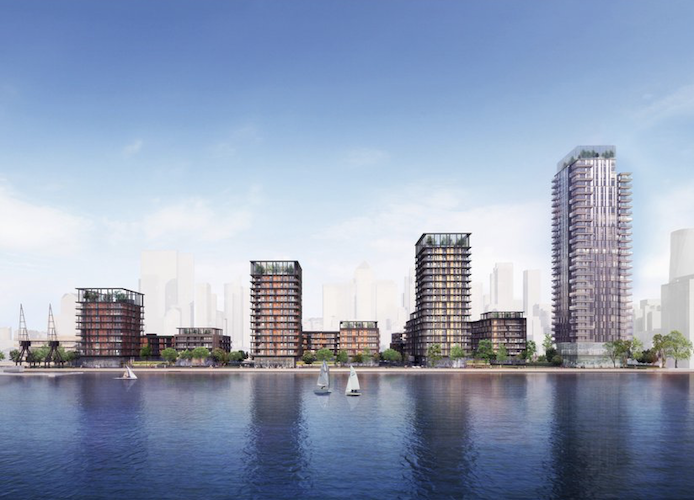Somewhat under the radar, given other things going on, the government has finally killed off the controversial 1,500-home Westferry Printworks development on the Isle of Dogs which last year saw the then communities secretary Robert Jenrick’s original approval overthrown because of his “apparent bias”.
Jenrick’s January 2020 backing for media magnate Richard Desmond’s scheme, which went against his own planning inspector’s recommendation, saved the developer some £40 million under new Tower Hamlets Council Community Infrastructure Levy (CIL) rates which came in just a day after the minister’s decision.
Desmond had discussed the application with the minister at a Tory fundraiser, subsequently donating £12,000 to the party, and had warned Jenrick by text that approval was needed “before Jan 15 otherwise payment of 45 million pounds to tower hamlets…”, it was later revealed.
A further text from Desmond to Jenrick said: “We appreciate the speed as we don’t want to give Marxists loads of doe [sic] for nothing!”
In High Court action brought by Tower Hamlets last year Jenrick accepted that the timing of his decision would lead the “fair minded and informed observer to conclude that there was a real possibility that he was biased in favour of the developer” – though there was no “actual bias”, the government said.
The scheme, featuring five tower blocks ranging from 19 to 44 storeys stretched along the north side of Millwall Outer Dock, was to replace previous plans for 722 homes in blocks up to 30 storeys high, which had been pushed through by Boris Johnson just a week before he ceased to be London Mayor in 2016.
The same court action also saw the newer Desmond plans go back to the same planning inspector, David Prentis, who had recommended their refusal in the first place. A fresh hearing took place in May. Now, the final decision has been taken by junior minister Eddie Hughes MP.
Unsurprisingly, Prentis came to the same conclusion as before, starting as he did from his previous scrutiny. This was despite Desmond’s barrister Paul Brown QC arguing that things had changed, including, somewhat ironically, that Tower Hamlets would now be collecting the £43 million CIL money if the scheme was approved.
The continuing impact of the Covid pandemic on house-building and the wider economy was another factor, Brown told the inquiry, meaning that the scheme’s 1,524 homes, delivering “far more economic benefits” than Desmond’s original plans for fewer than half as many homes, were needed more than ever.
Covid had seen a 165 per cent increase in Tower Hamlets residents claiming benefits, while the government had promised that the planning system would deliver a “transformative ‘new deal’ for the economy”, he said. “The site sits ready, waiting to make its contribution.”
It’s an argument increasingly common in planning disputes, including the recent debate over the Tulip visitor attraction in the City. As in that case, it got short shrift.
There was no government guidance that planning decisions should be taken other than on the normal basis, while the developers’ own consultants had forecast recovery by the end of 2022, well before the scheme would be generating significant economic benefits, Prentis said.
So it was back to the established Tower Hamlets requirement that development in the area should be “subservient to” and “step down” in height and to the south and west of the dominant Canary Wharf “cluster” of tall buildings.
The Desmond scheme did the opposite, the inspector found, with its “excessive height, scale and mass” also harming the settings of the Old Royal Naval College in Greenwich, the Maritime Greenwich world heritage site as a whole, and Tower Bridge, as well as affecting sailing conditions on the well-used dock.
Independent local councillor Andrew Wood, who has campaigned against the plans while giving in principle support to the initial smaller scheme, welcomed the ruling on heritage impact as potentially helping to “reduce the size” of future developments.
Wood agreed that Tower Hamlets and London as a whole need more homes, but said the “fundamental problem” remained that the Isle of Dogs E14 area, which already has the five tallest residential buildings in the UK, was heading toward “Manhattanisation”, without proper planning. A seven block scheme up to 65 storeys to the north of Canary Wharf was approved last month, and more are in the pipeline.
A representative of the developers told the inquiry that the 722-home 2016 scheme approved by Johnson would go ahead if the revised plans were rejected.
Update 24 November 2021.
In a statement following the Westferry decision Tower Hamlets Mayor John Biggs said:
“The decision on Westferry Printworks is the latest chapter in the
“When Robert Jenrick approved
There were allegations he ignored forceful reasons for refusal and rushed through the decision to save the
I’m pleased that now, after many months and two public inquiries, both the inspector and the new Secretary of State share the council’s view that the larger scheme should be refused permission. It was inappropriate for the site in both scale and height, had significant heritage impacts and only proposed 21 per cent affordable housing.
The smaller scheme originally approved in 2016 can still be built and we’ll continue to work to ensure any development here delivers the maximum benefit for our
On London is a small but influential website which strives to provide more of the kind of journalism the capital city needs. Become a supporter for £5 a month or £50 a year and receive an action-packed weekly newsletter and free entry to online events. Details here.

